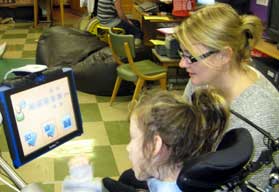Scientists in Scotland have developed a system that allows children with communication difficulties to take control of conversations.
How was school today? uses a combination of software and hardware to enable children with disabilities such as cerebral palsy and learning difficulties to have conversations in a faster, more interactive way.
The system is the result of a year-long collaborative project between computing scientists from Dundee and Aberdeen universities and Capability Scotland.
Dr Ehud Reiter, from Aberdeen University's School of Natural and Computing Sciences, said: 'How was school today? uses sensors, swipe cards and a recording device to gather information on what the child using the system has experienced at school that day. This can then be turned into a story by the computer - using natural language generation software - which the pupils can then share when they get home.
Rolf Black, from Dundee University's School of Computing, said: 'For a child with severe motor disabilities and limited or no speech, holding a conversation is often very difficult and limited to short one- to two-word answers. To tell a longer story a communication device is often needed to form sentences but this can be very time consuming, putting a lot of strain on holding and controlling the conversation.'

The new system uses a sensor attached to a child's wheelchair that tracks and records where they are going within their school day.
Swipe cards are then used by the teachers or carers, who interact with the child to tell the system who the child has met and what activity they have been involved in.
A recording device is also incorporated in the system, which allows people who come into contact with the child to record more detailed information about the events that have taken place within the youngster's day.
Natural language generation software is then used to convert the sensor data into English, generating simple sentences that summarise events during the day. For example, if the sensor data places the child in a hall after lunch, the system would generate a sentence such as: 'After lunch I went to the hall.'
The software also allows the system to generate appropriate comments. If child came into contact with a person called Anne who swiped her card to register her presence, the system might generate: 'Anne was there.'
If the child then chooses to add a positive comment by pressing a smiley face, the system would automatically generate: 'she is nice.'
The researchers plan to assess how the technology could be integrated into the communication devices used by children with severe motor disabilities and widened to incorporate conversations around other themes.




Swiss geoengineering start-up targets methane removal
No mention whatsoever about the effect of increased methane levels/iron chloride in the ocean on the pH and chemical properties of the ocean - are we...